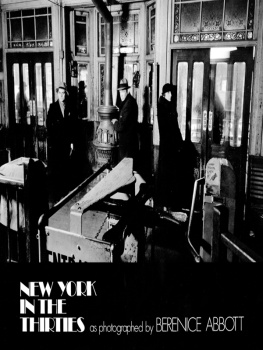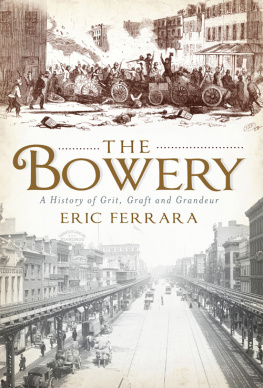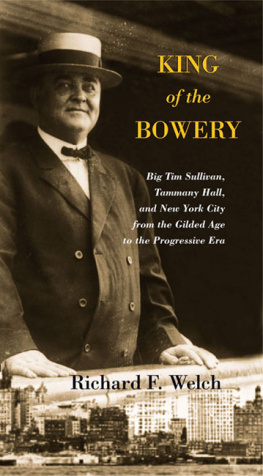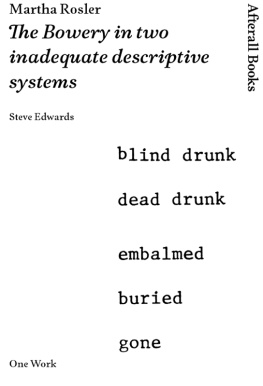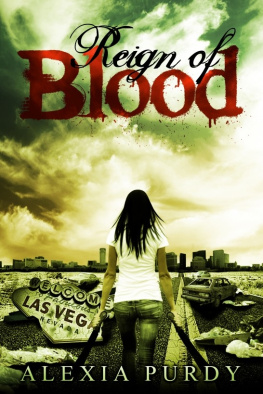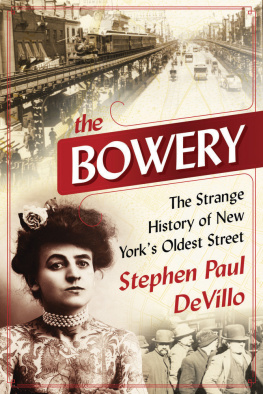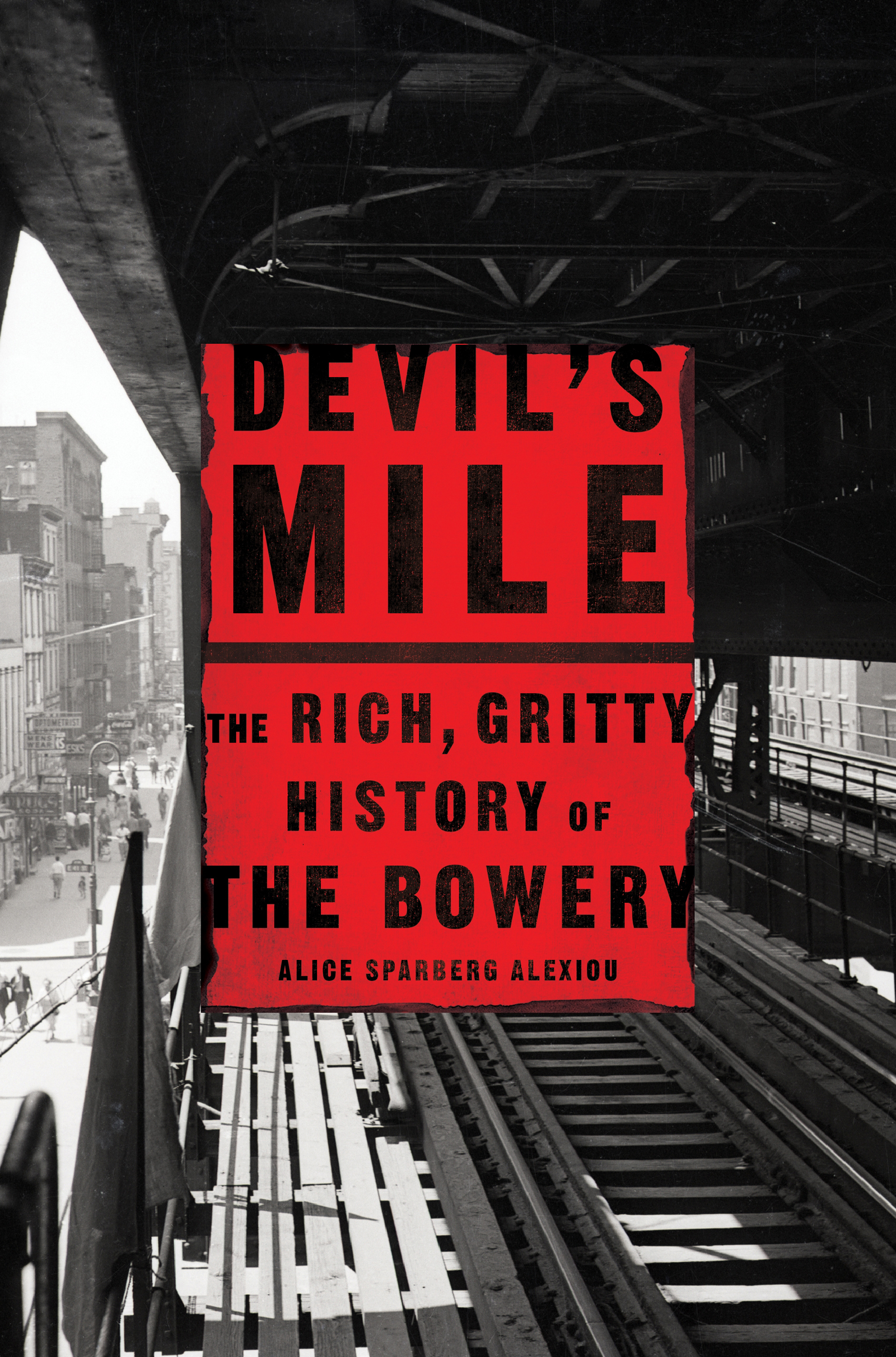Contents
Guide
Pagebreaks of the print version
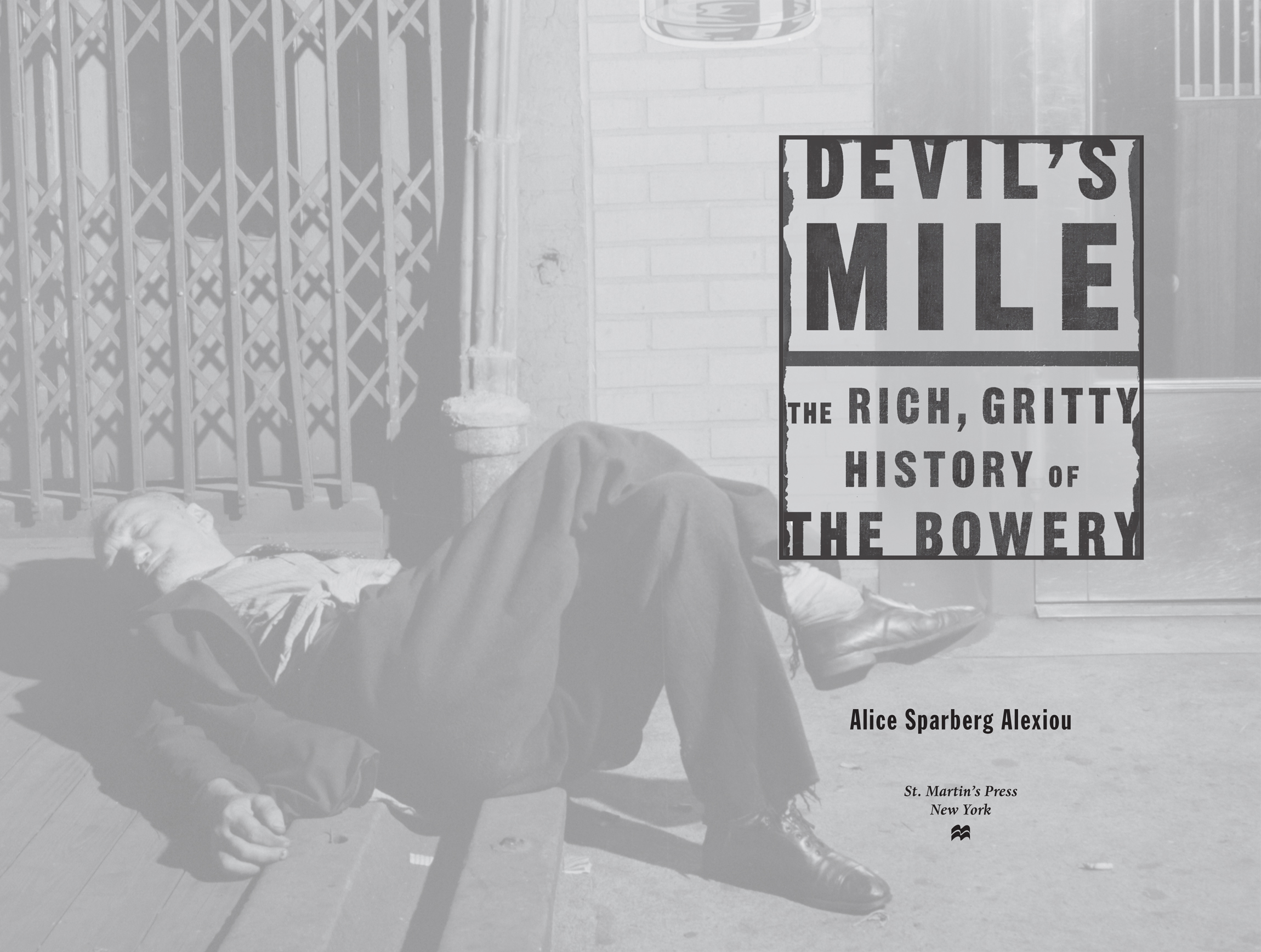
The author and publisher have provided this e-book to you for your personal use only. You may not make this e-book publicly available in any way. Copyright infringement is against the law. If you believe the copy of this e-book you are reading infringes on the authors copyright, please notify the publisher at: us.macmillanusa.com/piracy.
To my sons, Alex and Joseph Alexiou
To see the Bowery in its glory, one must visit it at night. It is a blaze of light from one end to the other. The saloons, theatres, concert halls, and free-and-easys are gayly ornamented with lamps of all colors, and the lights of the street venders give to the sidewalks the appearance of a general illumination. The concert halls are filled, and sounds of music and shouts of laughter float out from them into the street. Wretched transparencies mark the entrances to the low dives, in and out of which a steady throng pours. The pavements are full of abandoned women, boldly plying their trade, regardless of the police, who are out in force along the thoroughfare. The larger German music halls have the only respectable audiences to be found in the Bowery. The shooting-galleries are a feature of the streets, and are brightly lighted and open to the sidewalk. They are ornamented with targets consisting of gaudily-painted figures, and offer innumerable inducements to passers-by to try their skill. The theatres are brilliant with transparencies and illuminated glass signs, and are well filled with pleasure-seekers. Men and women in all stages of intoxication stagger along the pavements, and here and there is a sturdy policeman with some offender in his grasp, hastening on to the station-house. Vice offers every inducement to its votaries, and the devils work is done nightly upon a grand scale in the Bowery. The horse-cars, with their colored lights and jingling bells, and the rapidly rushing elevated trains over-head, give an air of briskness to the street. The scene is gay and animated, but must be witnessed to be properly appreciated.
J AMES M C C ABE J R.,
New York by Sunlight and Gaslight , 1882
Once upon a time, the Bowery was the street synonymous with despair.
It was where you went to drink away your sorrows. The mere mention of it invoked images of bums passed out on the sidewalk. People called it Satans Highway, the Mile of Hell, the Devils Work, the Street of Sorrows, the Street of Forgotten Men, the One-Way Street. Officials were always wringing their hands over the bad old Bowery. Sometimes they made half-hearted attempts to clean it up. But New Yorks outcasts needed a place that embraced them, and so did the city. For more than a century, the Bowery functioned as New Yorks dumping groundand also its shame. So much so that the little businesses along the Bowerystationers, dry goods sellers, jewelers, hattersperiodically asked the city to change the streets name. To have a Bowery address, they claimed, was hurting them; people did not want to venture there.
But during the 1990s, as New York was exploding into a real estate frenzy, developers discovered the Bowery. Starting around 2000, they rushed in and began tearing it down. Today, the bad old Bowery no longer exists. A Whole Foods, the bersymbol of gentrification, stands on what was once an empty lot where the bums burned old insulation over oil drums to extract metal to sell to junk dealers. Former dive bars are now hipster nightspots, and the flophouses that sheltered the down-and-out have been converted into expensive lofts. Or they have been torn down and replaced with glass-and-concrete condos and hotels that rise to heights never before seen there. The privileged young urbanites buying these apartments talk about Bowery bars, but they have never heard of the expression Bowery bum.
The New York City government, grateful that private interests are solving the Bowery problem that bedeviled New York for more than a century, encourages development along this once-infamous street. At the same time, the city is destroying the Bowerys heart. The destitute who once congregated there and the many artists who existed side by side with the bums are being pushed out as the ramshackle buildings where they livedsome of them nearly 200 years old and of immense historic valueare destroyed.
By the 1930s, the Bowery was famous as the place where lost souls ended up and drank themselves to death. The Bowery bum became a permanent image in American culture. But before that, the Bowery was many things. It played a crucial part in every phase of New Yorks history.
The Boweryand so, too, Broadway, New Yorks other legendary thoroughfarewas originally a Lenape footpath. Each corridor was part of a network of trails that the Indians At this point, Broadway and the Bowery remain briefly parallel to each other before once again angling in opposite directions and continuing north.
These two streets came to personify New York, but in opposite modes: To be on Broadway implied having attained the glittery apex of success. But the Bowery meant Loserville.
Something else: people often say that the Bowery is New Yorks oldest street, but you can make this claim equally about Broadway. When the Dutch landed in Manhattan in the 1620s, they appropriated both of the original Indian paths, widened them, and used them as their highways; which one they used first is anybodys guess. (When I asked Jack Eichenbaum his take on this, he said, My guess would be Broadway. The Dutch were very water oriented for transportation; the lower shorelinePearl Streetwas likely navigated rather than used as a street.) Between Broadway and the Bowery, they carved out farms; the name Bowery comes from bouwerij, the old Dutch word for farm. During the eighteenth century, as the city began to expand beyond the original settlement at Manhattans southern tip, wealthy merchants built country estates along the Bowery. But by the Civil War, Broadway was becoming genteel. Rich folks were moving those few blocks west to Broadway or to the still-pristine woods of northern Manhattan. They left behind the Bowery to immigrants and the working classes, and it was then that the street became defined by the characteristics we have long associated with it: noise, dirt, poverty, tawdry entertainment, homelessness, the underground arts scene, wholesale commerce, restaurant supply places. In his famous book How the Other Half Lives , the social reformer and photojournalist Jacob Riis called the Bowery the great democratic highway of the city.
It is difficult to define the Bowery. Today, real estate brokers sell it as New Yorks hottest new neighborhood, but the Bowery is a two-way thoroughfare and therefore denotes motion: starting at Chatham Square and ending at Cooper Union, it runs through Chinatown, the Lower East Side, Little Italy, and Tribeca. Back in the days of New York ward politics, these neighborhoods corresponded to the Fourth, Sixth, and Tenth Wards, and the Bowery comprised a piece of all of them. But it didnt fully belong to any one ward. While ward bosses sometimes fought for control of the Bowery, the only one who ever succeeded was Tammany bigwig Big Tim Sullivan, whom they called King of the Bowery.
You might see the Bowery as a state of mind where all manner of human interaction was permitted to take place, right out in the open. Once upon a time, it was where people bought, sold, and pawned cheap goods during the day. At night it was where prostitutes solicited, slummers came from all over the city to the dime museums, and cutting-edge music was inventedfirst in the concert saloons and later at CBGBs. The Bowery was where you went for a good time, and it was dangerous. It was also New Yorks earliest theater district. Yiddish theater, precursor to the Broadway musical, began on the Bowery. In fact, much of American popular entertainment was invented on the Bowery: tap dancing (an amalgam of Irish and black elements), vaudeville, the songs of Stephen Foster, punk rock.




